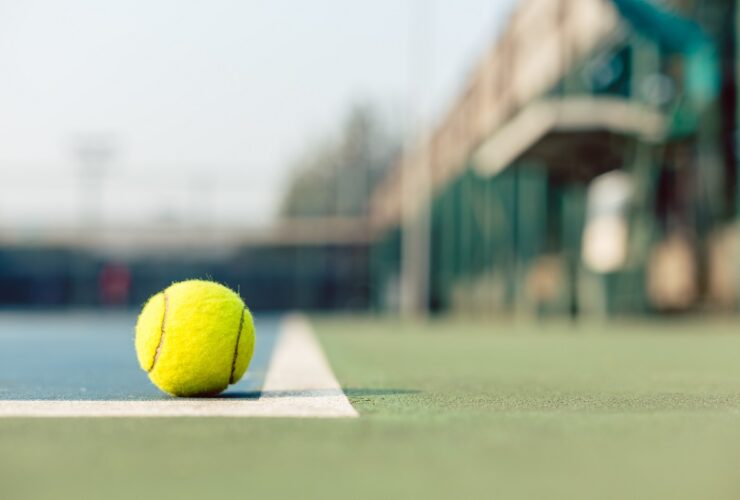The Importance of Tennis Court Drainage Systems: Ensuring Proper Water Management
Tennis is a beloved sport that combines athleticism, strategy, and precision. Whether you’re a professional player or a recreational enthusiast, the quality of the tennis court plays a vital role in your overall experience.
While factors like court surface and maintenance are often emphasized, one crucial aspect that is overlooked is the tennis court drainage system. Adequate water management is essential to maintain a high-quality playing surface, prevent surface damage, enhance player safety, and extend the lifespan of the court.
And in this blog post, we’ll explore the significance of well-designed drainage systems for tennis courts. More importantly, our tennis surface contractors have provided insights into your home tennis court’s key components and maintenance considerations.
Challenges Posed by Water Accumulation
Tennis courts are frequently exposed to various weather conditions, including rain, snow, and morning dew. And without proper drainage systems, these natural elements can wreak havoc on the court’s surface.
Water accumulation can lead to a range of issues, including:
- Surface Damage: Excessive water on the court can cause the surface to become slippery, affecting players’ traction and increasing the risk of injuries. Prolonged exposure to moisture can also result in the growth of moss, algae, and mildew, which can deteriorate the court’s surface and compromise its structural integrity.
- Uneven Playing Conditions: Waterlogged areas on the court can create uneven playing conditions, making it challenging to maintain a consistent bounce and affecting the overall fairness of the game. This can lead to frustration for players and hinder their performance.
- Erosion and Structural Damage: When water is not effectively drained, it can seep into the sub-base of the tennis court, causing erosion and structural damage. This can result in cracks, unevenness, and sinking of the surface, requiring costly repairs and potentially rendering the court unusable.
Related Article: Tennis Court Net Systems: Types, Installation, and Maintenance
Benefits of Effective Water Management
Installing a well-designed tennis court drainage system offers numerous benefits that positively impact both players and the longevity of the court. Let’s explore some of these benefits:
- Player Safety: Ensuring a safe playing environment should be a top priority for tennis court owners and facility managers. Effective drainage systems help remove excess water from the court’s surface, minimizing the risk of slips, falls, and related injuries. Dry courts provide optimal playing conditions and allow players to focus on their game without safety concerns.
- Surface Durability: Tennis court surfaces are designed to withstand the rigours of intense gameplay. Constant exposure to water can compromise their integrity. Drainage systems prevent standing water and minimize the impact of moisture on the court’s surface, reducing the risk of cracking, warping, and other forms of damage. This, in turn, extends the lifespan of the tennis court and reduces the need for costly repairs or resurfacing.
- Consistent Playing Conditions: Proper water management ensures that the court maintains consistent playing conditions, regardless of weather conditions. By effectively draining water, the court’s surface remains dry, allowing players to enjoy a predictable bounce and reliable traction. This enhances the overall quality of the game and promotes fair competition.

Key Components of Tennis Court Drainage Systems
To achieve effective water management for tennis courts, it’s important to understand the key components of a well-designed drainage system. These components work together to ensure efficient water removal and prevent water accumulation.
Here are the primary components:
- Subsurface Drainage: This component involves the installation of perforated pipes beneath the court’s surface. These pipes collect water that seeps through the court’s layers and directs it away from the playing area. They ensure water is efficiently drained, preventing sub-base saturation and potential structural damage.
- Surface Drainage: Surface drainage systems consist of strategically placed channels and drains on the court’s surface. These channels capture water accumulating during rain or irrigation and direct it toward the drainage system. Surface drains are particularly effective for removing water from areas prone to standing water, such as low-lying sections or depressions on the court.
- Grading: Proper grading is crucial for effective water flow on the tennis court. The court’s surface should be slightly sloped to allow water to flow naturally towards the drainage outlets. The degree of slope required depends on factors such as the court’s dimensions and surface material. An experienced professional can assess the specific requirements and ensure optimal grading for efficient water management.
Maintenance Considerations for Tennis Court Drainage Systems
Regular maintenance is essential to ensure the continued functionality of your tennis court drainage system. Here are some key maintenance considerations:
- Regular Inspection: Periodic drainage system inspections are crucial to identify any signs of damage or blockages. Inspect the surface drains, channels, and outlets to ensure they are clear of debris and functioning properly. If any issues are detected, prompt repairs should be carried out to prevent further damage.
- Cleaning: Clear any debris, leaves, or dirt that may accumulate in the surface drains and channels. This will ensure unobstructed water flow and prevent clogging. Additionally, remove any vegetation or moss growth on the court’s surface to maintain optimal playing conditions.
- Professional Expertise: Engaging the services of a professional tennis court maintenance company is highly recommended. These experts have the knowledge and experience to assess the drainage system’s performance, carry out necessary repairs or modifications, and provide guidance on the best practices for maintaining a dry and well-drained tennis court.
Related Article: How Much Does It Cost to Build a Home Basketball Court?

Final Thoughts
Proper water management is vital for maintaining high-quality tennis courts and ensuring player safety. Tennis court drainage systems play a crucial role in preventing surface damage, providing consistent playing conditions, and extending the lifespan of the court.
By investing in well-designed drainage systems and conducting regular maintenance, tennis court owners and facility managers can create an optimal playing environment that enhances the overall experience for players and protects their valuable assets.
Our tennis surface contractors at Crowall can answer any questions you have about a drainage system. We’ll help you enjoy the game you love, regardless of weather conditions, and appreciate the benefits of a dry, safe, and well-maintained court.


